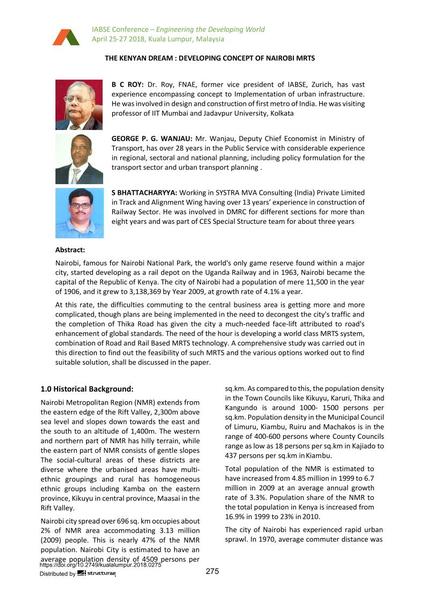The Kenyan Dream: Developing Concept of Nairobi MRTS

|
|
|||||||||||
Détails bibliographiques
| Auteur(s): |
B. C. Roy
(FNAE, former vice president of IABSE, Zurich)
George P. G. Wanjau (Mr. Wanjau, Deputy Chief Economist in Ministry of Transport) Satyaki Bhattacharjee (SYSTRA MVA Consulting (India) Private Limited) |
||||
|---|---|---|---|---|---|
| Médium: | papier de conférence | ||||
| Langue(s): | anglais | ||||
| Conférence: | IABSE Conference: Engineering the Developing World, Kuala Lumpur, Malaysia, 25-27 April 2018 | ||||
| Publié dans: | IABSE Conference Kuala Lumpur 2018 | ||||
|
|||||
| Page(s): | 275-282 | ||||
| Nombre total de pages (du PDF): | 8 | ||||
| DOI: | 10.2749/kualalumpur.2018.0275 | ||||
| Abstrait: |
Nairobi, famous for Nairobi National Park, the world's only game reserve found within a major city, started developing as a rail depot on the Uganda Railway and in 1963, Nairobi became the capital of the Republic of Kenya. The city of Nairobi had a population of mere 11,500 in the year of 1906, and it grew to 3,138,369 by Year 2009, at growth rate of 4.1% a year. At this rate, the difficulties commuting to the central business area is getting more and more complicated, though plans are being implemented in the need to decongest the city's traffic and the completion of Thika Road has given the city a much-needed face-lift attributed to road's enhancement of global standards. The need of the hour is developing a world class MRTS system, combination of Road and Rail Based MRTS technology. A comprehensive study was carried out in this direction to find out the feasibility of such MRTS and the various options worked out to find suitable solution, shall be discussed in the paper. |
||||
